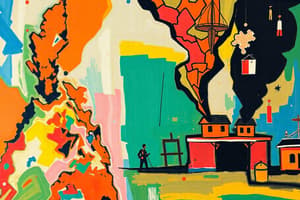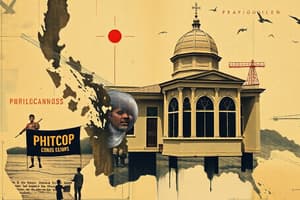Podcast
Questions and Answers
What can be said about the colonial policies in the Philippines?
What can be said about the colonial policies in the Philippines?
- They were designed to minimize economic exploitation.
- They prioritized the establishment of local democratic systems.
- They focused solely on local governance.
- They aimed to assimilate the local population into European culture. (correct)
How do colonial policies in Southeast Asia differ from those in the Philippines?
How do colonial policies in Southeast Asia differ from those in the Philippines?
- Southeast Asia's policies varied significantly by region. (correct)
- Both regions experienced identical economic exploitation.
- Southeast Asia focused solely on military control.
- Southeast Asia had a unified approach to colonization.
What were a primary aspect of the colonial policies in the Philippines?
What were a primary aspect of the colonial policies in the Philippines?
- Establishment of plantation economies.
- Encouragement of local customs and culture.
- Suppression of indigenous languages. (correct)
- Promotion of religious diversity.
Which of the following was NOT a characteristic of colonial policies in Southeast Asia?
Which of the following was NOT a characteristic of colonial policies in Southeast Asia?
What was a common effect of colonial policies in both the Philippines and Southeast Asia?
What was a common effect of colonial policies in both the Philippines and Southeast Asia?
Flashcards are hidden until you start studying
Study Notes
Colonial Policies in the Philippines and Southeast Asia
- General Colonial Policies in the Philippines were often focused on economic exploitation and political control.
- General Colonial Policies in Southeast Asia were diverse and varied greatly depending on the colonizing power and the specific region.
- Philippines Colonial Policies:
- Spanish Colonization (1565-1898):
- Established a colonial government and controlled trade.
- Exploited natural resources such as gold, silver, and timber.
- Introduced Christianity and Spanish language.
- Implemented forced labor systems like the polos y servicios.
- Created social hierarchies based on race and religion.
- American Colonization (1898-1946):
- Established a new government with a democratic framework.
- Modernized infrastructure, including education and healthcare.
- Promoted free trade and economic development.
- Used policies to benefit the American economy.
- Developed policies aimed at assimilating Filipinos into American culture
- Spanish Colonization (1565-1898):
- Southeast Asia Colonial Policies:
- European Colonization (16th-20th centuries):
- British, French, Dutch, and Portuguese dominated different regions.
- Exploited agricultural resources, such as rubber, tea, and spices.
- Controlled trade routes and extracted raw materials.
- Implemented colonial administration systems with varying degrees of autonomy.
- Enforced social and cultural changes through education, religion, and language.
- Introduced new technologies and infrastructure, but often to benefit the colonizer.
- Led to political and economic instability and social unrest.
- Often used divide-and-rule tactics, manipulating ethnic and religious tensions for their advantage.
- Japanese Occupation (1940s):
- Expanded Japanese influence during World War II.
- Exploited resources for the war effort.
- Promoted Japanese culture and language.
- Established puppet governments and used harsh repressive measures.
- European Colonization (16th-20th centuries):
Studying That Suits You
Use AI to generate personalized quizzes and flashcards to suit your learning preferences.




